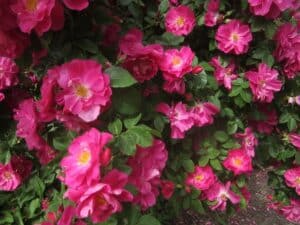Hello, fellow lovers of all things green,
What a treat to learn about John Cabot Roses through a story shared by a writer friend, Koleen Garland, who lives in Canada. She titled her “two-hour writing binge” (meaning first draft, hard to believe)—That Indestructible, Irresistibly Beautiful John Cabot Rose. I have not had luck growing roses; it’s like a wrestling match with diseases and pests. But Koleen’s story gives me hope.

Koleen’s John Cabot Rose
“Aren’t all we gardeners alike? Give it a chance!”
At one time, I ordered a rose by mail. And I got a surprise. The bare roots inside the package left in my mailbox looked like a collection of dried-up twigs. But the label said it was indeed what I had ordered – a John Cabot Rose. That, I decided, was a stretch of the imagination, but I planted it anyway just in case it grew – aren’t all we gardeners alike? Give it a chance! I dug it into an abandoned sheep manure pile on the north side of our huge barn. On its third birthday, it rewarded me with a seven-foot-high fountain of nearly six hundred blossoms.
Shortly after that, our farm was sold. I was heartbroken that the beautiful rose was going to be left. But without anyone else knowing it, our son drove the tractor loader under its graceful branches and, in one scoop, wrenched it out of the ground. He then dumped it unceremoniously into the back of a pick-up truck and drove it 120 miles to his house in sub-freezing December weather. He dropped it beside his back patio and pushed some snowy earth around it. That was twenty years ago, and to this day, it dutifully and magnificently out-blooms anything around.
Attributes of the Indestructible, Irresistibly Beautiful John Cabot Rose
John Cabot is one of the hardy shrub Explorer roses that came out of Canada Agriculture’s research experiment to create roses that could survive our harsh Canadian climates. Starting in the 1960’s several names were allocated from our historic past to newly baptized roses before John Cabot was named in 1978. The large plant is formally called a climber (and it could be persuaded to do so), but I never bothered with the climbing end of things. Instead, I let it become a fountain that gracefully extends branches all around the plant, sometimes touching the ground.

John Cabot Rose
The clusters of blooms form down each branch, each vying for attention. It takes a few years to get to this stage, but in the meantime (John Cabot) makes life easy for the gardener. Deer don’t touch it, rabbits and mice can’t get through the thorns, aphids don’t like it, and it doesn’t get thrips, mildew, or black spot.
Holy moly, Koleen, maybe even I can grow this beauty.
Although my zone 5 doesn’t challenge it, I’m betting it could make it through the zone 3 it is rated for with no winterizing needed. Just prune it back in the Spring when the green comes back to the branches, and prune other branches that are just not in the right place.
John Cabot blossoms are almost red in the bud, then turn dark pink when open. They are three-inch wide double rowed with 40 plus petals. And deadheading? Well if you wish to patiently deadhead, more power to you. One of mine had 1500 blooms last year (give or take a few hundred). But even if you don’t deadhead, John Cabot will keep on blooming sporadically all through the summer and end the season with a good-sized blush just for good measure.
(Those that may not know, deadheading is cutting off the spent blooms. Can you imagine cutting off 1500 blooms?)
“My home isn’t my home unless I have my favorite roses.”
Koleen writes, I recently moved to another city, and yes, I have to have my small collection of roses. Firstly, my trademark, John Cabot, then my husband’s favorite, a light pink John Davis (only three feet high).And, of course, the pure white Henry Hudson (also small enough for a perennial border). They are all named after explorers who mapped out our newly found country in its infancy.

John Cabot Roses
I found a beautiful John Cabot at my local garden center. When I looked at where it had come from, I was surprised. It seems that many of the Explorer Rose Series are now started in Michigan. We are on the same latitude, and I’m happy to say we can share our bounty. Beauty knows no boundaries, and anyway – Mother Nature doesn’t give a darn about the 49th parallel. Explorer roses are easy to grow and maintain, and they are show-stoppers. How can you beat that?
Thank you, Koleen. You are turning my love-hate relationship with roses into one of hope that maybe even I can grow them.
Garden Dilemmas? AskMaryStone@gmail.com and your favorite Podcast App.
What is the 49th parallel?
I had to look up the significance of the 49th parallel—the latitude 49 degrees north of the equator crossing Europe, Asia, North America, and the Pacific and Atlantic Oceans. Per Mr. Nussbaum’s Learning + Fun, Great Britain withdrew from America after the War of 1812 but still controlled much of Canada. In the spirit of establishing diplomacy between nations, the United States and Great Britain agreed to define the boundaries between territories along the 49th parallel at the Anglo-American Convention of 1818.
So there you go, a rose lesson and a bit of history and geography. You can beat that. Thank you, Koleen!
You can tune into Koleen’s whole story (a soothing 10 minutes) in the Garden Dilemmas Podcast:
“Flora Forever”: We wrap up the episode with inspiration from a child I met while volunteering at Comfort Zone Camp (a bereavement camp for kids.)The young arborist-to-be is already an explorer of plants; may we all be the same.


